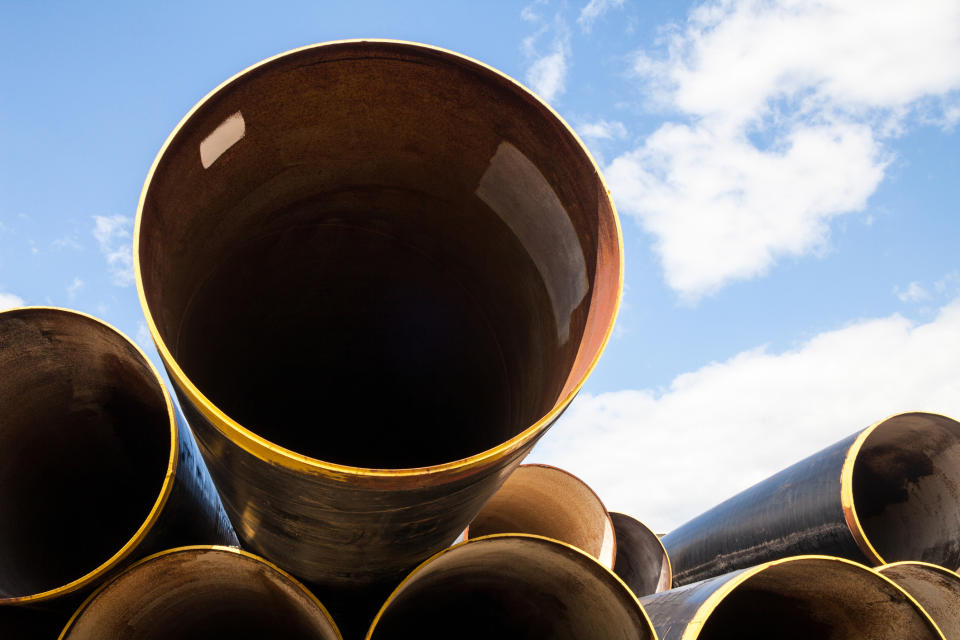The 10 Biggest MLP Stocks
Master limited partnerships (MLPs) are entities that pass through income to their investors. Because of that, they don't pay income tax at the corporate level. That enables their investors to collect above-average cash distributions, making MLPs tailored to those seeking income.
To meet the requirements for this tax advantage, MLPs must earn 90% of their income from qualifying sources as determined by the Internal Revenue Service. Qualifying activities include the exploration, production, processing, and transportation of natural resources, as well as some investment-related activities such as owning commercial real estate. Because of that, most MLPs are found in the energy or financial sectors.
This guide will walk you through the 10 biggest MLPs so that you understand the competitive advantages that enabled these 10 to become the largest companies in this space.

Image source: Getty Images.
An overview of the MLP market
MLPs make up a small part of the overall stock market. While the U.S. stock market's value changes daily, it was worth about $34 trillion in early 2018, which at the time was 43% of the global market. The entire MLP market, on the other hand, accounted for 1.4% of that total, and was worth roughly $460 billion at that time.
Approximately 80% of the MLPs by market value are in the energy and natural resources sector, with 90% of those companies focused on the midstream oil and gas space (companies that work together to help a market operate efficiently). As such, it should be no surprise to see that eight of the 10 largest MLPs as measured by their enterprise value -- which adds market capitalization to net debt -- made most of their money from energy midstream activities:
The 10 Largest MLPs | Enterprise Value | Focus Area |
|---|---|---|
Energy Transfer (NYSE: ET) | $94.9 billion | Diversified midstream |
Enterprise Products Partners (NYSE: EPD) | $93.5 billion | Diversified midstream with a focus on natural gas liquids |
Brookfield Property Partners (NASDAQ: BPY) | $90.6 billion | Office and retail properties |
MPLX (NYSE: MPLX) | $39.5 billion | Refinery-related logistics, and natural gas gathering and processing |
Brookfield Infrastructure Partners (NYSE: BIP) | $38.3 billion | Energy, transportation, data, and utility infrastructure |
Cheniere Energy Partners (NYSEMKT: CQP) | $37.1 billion | Liquefied natural gas export terminals |
Brookfield Renewable Partners (NYSE: BEP) | $28.7 billion | Hydroelectric power plants |
Plains All American Pipeline (NYSE: PAA) | $26.9 billion | Oil pipelines |
Western Midstream Partners (NYSE: WES) | $21.5 billion | Producer-focused oil and gas gathering |
Magellan Midstream Partners (NYSE: MMP) | $19.3 billion | Refined petroleum products infrastructure |
Data source: YCharts. Enterprise value as of July 11, 2019.
While most of the largest MLPs make the bulk of their money operating midstream assets, each specializes in different areas of the market. This focus allowed them to build out dominant positions in their respective niches before they branched out into other areas. Here's a closer look at what defines each of these MLPs, giving them the competitive advantages necessary to grow into one of the largest in the sector.
Energy Transfer: A diversified MLP behemoth
Energy Transfer operates a fully integrated platform that spans the entire energy-midstream value chain. While the company initially focused on natural gas pipelines, it had more than 86,000 miles of all types of pipelines throughout the U.S. in the middle of 2019. These systems transport natural gas, crude oil, natural gas liquids (NGLs), and refined petroleum products from all major supply basins to every top market center in the country. It also operated an extensive portfolio of processing, storage, and export facilities. Energy Transfer typically gets a fee as volumes flow through its systems. That enables it to make money at nearly every stage as oil and gas move from wells to end-users.
Because Energy Transfer focuses on operating assets that earn fees, it has limited direct exposure to volatile commodity prices. In 2018, for example, long-term fixed-fee contracts supported about 90% of its earnings. That provides predictable cash flow, which it can distribute to investors. In 2019, the company paid out about half of its cash flow to its unitholders. It retained the rest to help finance expansion projects.
One of the benefits of having such a diversified footprint is that it opens lots of avenues to expand. The company has the flexibility to pursue the highest-return opportunities to transport, process, store, and export any energy-related commodity. That combination of scale and diversification has helped the MLP to grow at a fast pace, with it increasing its EBITDA at a 17% compound annual rate from 2015 through 2019. Meanwhile, with a strategically positioned asset base and sound financial profile, Energy Transfer has the resources to continue growing its earnings at a high rate for many years to come.

Image source: Getty Images.
Enterprise Products Partners: The NGL-focused MLP
Enterprise Products Partners is one of the largest midstream companies. It has a diversified footprint and integrated asset base that consisted of pipelines for natural gas, NGLs, oil, petrochemicals, and refined products, along with storage facilities, processing plants, and export terminals. Because of its diversification and integration, Enterprise Products Partners typically touches an energy molecule five to seven times as it passes through its system, earning a different fee each time.
But what sets Enterprise Products Partners apart from most other MLPs is its focus on NGLs. In 2018, 50% of the company's earnings came from services relating to those commodities. Meanwhile, it generated another 13% of its profits from petrochemical activities, which included transforming NGLs into the building blocks for plastics.
While Enterprise Products Partners isn't the only midstream company with NGL-related assets, it's the biggest in the space. Those large-scale operations give it a leg up on the competition when it comes to winning expansion-related opportunities. Meanwhile, the company's overall diversification gives it the flexibility to invest in other high-return projects that help expand its cash flow and distribution to investors.
Brookfield Property Partners: The global real estate mogul
Leading Canadian asset manager Brookfield Asset Management formed Brookfield Property Partners to be its primary vehicle to invest in all classes of real estate around the globe. The partnership does this through direct ownership in commercial real estate and investments in private funds managed by its parent.
The company's core portfolio consists of two classes of real estate: Class A office properties in the top cities around the world and best-in-class U.S. retail properties. These are irreplaceable assets in destination locations, which makes them in high demand. Because of that, Brookfield Property Partners can steadily increase rents, which gives it more cash flow to distribute to its investors. Brookfield Property Partners typically invests 80% of its capital into these core holdings.
The company invests the other 20% of its balance sheet into private real estate funds managed by Brookfield Asset Management. These funds hold a variety of real estate properties such as:
Multifamily
Logistics
Hospitality
Self-storage
Student housing
Retail
Office
The investments in these funds enable Brookfield Property Partners to generate higher investment returns since it aims to buy high-quality properties that the market has mispriced. While these investments do generate cash flow, it typically reinvests this money into other funds or core development projects.
By focusing on owning some of the best properties in the top markets, Brookfield Property Partners can steadily increase its rents. The company anticipates that its existing real estate portfolio, as well as its development projects, will grow its cash flow at a 7% to 9% annual pace through 2022. That should support 5% to 8% yearly increases in the cash distributions paid to its investors over that time frame.
MPLX: The ever-evolving MLP
Refining giant Marathon Petroleum formed MPLX in 2012 to own, operate, develop, and acquire midstream infrastructure assets. Initially, Marathon grew its MLP by dropping down its logistics assets, which consisted of oil and refined-products pipelines, storage terminals, and marine logistics assets. But MPLX has evolved over the years through a series of third-party acquisitions and expansion projects.
Those moves have transformed it into a full-service midstream company. In addition to the logistics services that are crucial to Marathon's refineries, it also provides a "wellhead to water" solution for producers. That enables them to get their oil and gas from wells to export facilities along the coast. Part of its evolution has included investing in long-haul pipeline projects that move oil and gas from production regions to market centers such as the U.S. Gulf Coast. These moves have helped reduce its reliance on Marathon to drive growth.
While MPLX operates midstream assets across several major production regions, its focus has been on expanding its presence in the fast-growing Permian Basin. The company has done this in several ways. For example, it merged with an MLP that Marathon acquired when it bought a rival refiner in 2018. It has also invested in new pipeline projects and other infrastructure developed by others. These investments enable the company not only to benefit from the stable cash flows they produce but also to continue expanding its export capabilities. Those factors should allow this MLP to continue increasing its high-yielding distribution.
Brookfield Infrastructure Partners: The global infrastructure giant
Brookfield Infrastructure Partners is another of the partnerships created by Brookfield Asset Management to drive its growth in certain segments of the market. In this case, Brookfield Infrastructure operates a portfolio of infrastructure assets around the world, focusing on four core areas:
Utilities: Traditional regulated electric and gas distribution companies, electricity transmission lines, and regulated natural gas pipelines.
Transportation: Railroads, toll roads, and ports.
Energy: Natural gas pipelines, storage, and processing plants; district heating and cooling systems, and residential infrastructure such as HVAC systems.
Data: Cell towers, data centers, and fiber optic cables.
The company's diversified approach to infrastructure and global scope provides several advantages. For example, it has more opportunities to grow since it can invest in several different industries and countries. As a result, it could potentially expand its cash flow at a faster rate than other MLPs while also earning higher returns. Furthermore, this approach enables the company to take advantage of more-favorable market conditions in different regions or asset classes so that it can make better deals. Those factors could help generate better total returns for its investors in the long term.

Image source: Getty Images.
Cheniere Energy Partners: The LNG MLP
Cheniere Energy Partners is an MLP formed by liquefied natural gas (LNG) giant Cheniere Energy to develop the Sabine Pass export terminal in Louisiana. The MLP planned to build six liquefaction trains at the location to transform natural gas into LNG, which it loads onto gas-carrying ships for export to global markets. The company completed its first LNG train in May 2016 and finished the fifth in February 2019. In June 2019, Cheniere approved the construction of the sixth train.
Cheniere Energy Partners earns a fee as it liquefies natural gas for customers under long-term contracts, which enables it to generate steady cash flow. The company pays out a large portion of that cash flow to investors, including its parent Cheniere Energy.
While Cheniere Energy Partners operates a growing LNG terminal, its parent chose to build its second facility in Corpus Christi, Texas, outside of its MLP. However, Cheniere Energy owns enough land at Sabine Pass to double the capacity of that facility in the future, which gives Cheniere Energy Partners plenty of room to grow. Meanwhile, it should have ample opportunity to expand since the global LNG market is on track to grow at a 4% compound annual rate through 2035 -- fueled by a 70% increase in energy demand over that time frame.
Brookfield Renewable Partners: The largest pure play on renewable energy
Brookfield Renewable Partners is another entity created by Brookfield Asset Management to own its direct investments. This entity holds assets that generate renewable energy, with its primary focus on operating hydroelectric plants. The company typically sells most of its power -- usually more than 85% of its anticipated output -- under long-term fixed-price contracts. That approach enables the company to generate predictable cash flow that it can distribute to investors.
While Brookfield Renewable Partners has traditionally focused on hydropower, the company has branched out into other renewables in recent years. It now operates a diversified portfolio that includes wind, solar, and energy-storage assets. This diversification has increased the growth opportunities. The company adds to that growth potential by having the flexibility to invest across the globe, as opposed to just in the U.S., which is where most of its peers focus.
The renewable-energy-focused partnership believes that a combination of cost reduction, improving electricity prices, and expansion projects will help power 6% to 11% annual cash flow growth through 2022. Add that growth to the company's high-yielding dividend and ability to make needle-moving acquisitions, and it's well positioned to generate market-beating total returns.
Plains All American Pipeline: The oil pipeline MLP
Plains All American Pipeline operates an extensive footprint of oil-related infrastructure such as pipelines and storage terminals. Its crude oil pipeline network stretches from Western Canada to the U.S. Gulf Coast and includes a large-scale position in the fast-growing Permian Basin. The company complements those assets with NGL pipelines and storage terminals as well as some natural gas storage assets.
The MLP typically signs long-term fee-based contracts with customers for capacity on its pipelines and at its storage terminals. Those agreements provide predictable cash flow that it uses to support its high-yield distribution. The company also retains some of its cash flow to help finance expansion projects.
With North American oil production expected to continue growing at a fast pace for several years, the industry will need more new infrastructure. An estimate by the INGAA Foundation, a natural-gas pipeline industry group, puts the oil-related infrastructure requirement alone at $321 billion by 2035. A large portion of that investment will be in the Permian Basin, where output is on track to double by 2025, reaching more than 8 million barrels per day. That's right in Plains All American's sweet spot given its dominant oil infrastructure position in that region.
Western Midstream Partners: Focused on the fastest-growing U.S. unconventional oil plays
Upstream oil and gas producer Anadarko Petroleum formed Western Midstream to own, operate, acquire, and develop infrastructure to support its growth. As such, the company focuses primarily on gathering and processing oil and gas in regions where Anadarko operated, particularly the Delaware and DJ Basins. Besides its footprint of production-related midstream assets, Western Midstream also owns stakes in several long-haul pipelines.
Its close relationship with Anadarko Petroleum -- which fellow oil and gas producer Occidental Petroleum agreed to acquire in 2019 -- sets it apart from the others on this list. That's because it relies heavily on its producing parent to drive growth since it's responsible for building the infrastructure needed to support newly drilled wells. As such, if Anadarko's successor slows its activities in areas dedicated to Western Midstream, it will likely cause the MLP to grow at a slower rate. On the other hand, this relationship provides a built-in growth driver for Western Midstream since it could expand its midstream footprint in support of its parent.
Magellan Midstream Partners: The refined petroleum products MLP
Magellan Midstream Partners operates the longest refined products pipeline system in the U.S., focused primarily on transporting gasoline and diesel throughout the Midwest and Texas. The company also operates a large crude oil transportation business as well as complementary marine storage and export assets. In 2018, the company made 59% of its money moving refined products, 34% from crude oil services, and the rest from marine-related logistics.
Magellan has grown its cash flow by extending its service capabilities. The company has gone from transporting finished refined products from refineries to market centers, to also supplying refineries with crude oil. And it has further boosted its cash flow by increasing its ability to export refined products as well as crude oil to global markets. That has enabled it to steadily grow its cash flow, supporting its ability to consistently increase its distribution to investors.
Magellan Midstream's large refined-products pipeline system gives it an advantage over smaller rivals in winning expansion projects. It's typically the service provider of choice for refineries that need additional capacity to move or store oil and finished products. That has enabled it to steadily secure new projects to expand its operations.
What each one of these large MLPs has in common
These 10 MLPs have grown into the largest in their sector by initially focusing on dominating their niche. That has enabled them to increase their scale to more easily expand into other areas. This approach has helped them become some of the largest and most valuable companies in this sector.
More From The Motley Fool
Matthew DiLallo owns shares of Brookfield Asset Management, Brookfield Infrastructure Partners, Brookfield Property Partners, Brookfield Renewable Partners L.P., and Enterprise Products Partners. The Motley Fool owns shares of and recommends Brookfield Asset Management. The Motley Fool recommends Brookfield Infrastructure Partners, Enterprise Products Partners, and Magellan Midstream Partners. The Motley Fool has a disclosure policy.
This article was originally published on Fool.com
